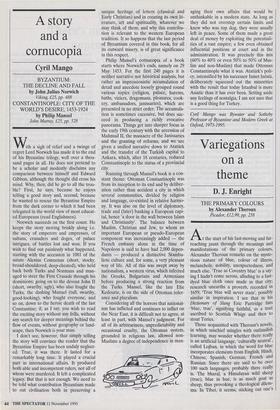A story and a cornucopia
Cyril Mango
BYZANTIUM: THE DECLINE AND FALL by John Julius Norwich Viking £25, pp. 488 CONSTANTINOPLE: CITY OF THE WORLD'S DESIRE, 1453-1924 by Philip Mansel John Murray, £25, pp. 528 With a sigh of relief and a twinge of regret Lord Norwich has made it to the end of his Byzantine trilogy, well over a thou- sand pages in all. He does not pretend to be a scholar and modestly disclaims any comparison between himself and Edward Gibbon, although the thought did cross his mind. Why, then, did he go to all the trou- ble? First, he says, because he enjoys telling a good story and, second, because he wanted to rescue the Byzantine Empire from the dark corner to which it had been relegated in the world view of most educat- ed Europeans (read Englishmen).
Norwich succeeds on the first count. He keeps the story moving briskly along i.e. the story of emperors and empresses, of sultans, crusaders and doges, of palace intrigues, of battles lost and won. If you wish to find out painlessly what happened, starting with the accession in 1081 of the astute Alexius Comnenus (short, stocky, broad-shouldered, deep-chested), who held back both Turks and Normans and man- aged to steer the First Crusade through his dominions; going on to the devout John II (short, swarthy, ugly), who also fought the Turks, the dashing Manuel (tall, swarthy, good-looking), who fought everyone, and so on, down to the heroic death of the last Constantine; if, as I say, you wish to read the exciting story without any frills, without any search for deeper meanings behind the flow of events, without geography or land- scape, then Norwich is your man.
I don't see, however, that simply telling the story will convince the reader that the Byzantine Empire has been unduly neglect- ed. True, it was there. It lasted for a remarkably long time. It played a crucial part in international affairs. It produced both able and incompetent rulers, not all of whom were murdered. It left a complicated legacy. But that is not enough. We need to be told what contribution Byzantium made to out civilisation both in preserving a unique heritage of letters (classical and Early Christian) and in creating its own lit- erature, art and spirituality, whatever we may think of them; and why this contribu- tion is relevant to the western European tradition. It so happens that the last period of Byzantium covered in this book, for all its outward misery, is of great significance in this respect.
Philip Mansel's cornucopia of a book starts where Norwich's ends, namely on 29 May 1453. For the first 240 pages it is neither narrative nor historical analysis, but rather an impressionistic accumulation of detail and anecdote loosely grouped round various topics (religion, palace, harems, baths, viziers, dragomans, pleasures, cook- ery, ambassadors, janissaries), which are presented in no strict order. The accumula- tion is sometimes excessive, but does suc- ceed in producing a richly evocative panorama. Things get into sharper focus in the early 19th century with the accession of Mahmud II, the massacre of the Janissaries and the granting of reforms, and we 'are given a unified narrative down to Atatiirk and the transfer of the Turkish capital to Ankara, which, after 16 centuries, reduced Constantinople to the status of a provincial city.
Running through Mansel's book is a con- stant theme: Ottoman Constantinople was from its inception to its end and by deliber- ation rather than accident a city in which several communities, divided by religion and language, co-existed in relative harmo- ny. It was also on the level of diplomacy, trade and (later) banking a European capi- tal, hence 'a door in the wall between Islam and Christianity'. The balance between Muslim, Christian and Jew, to whom an important European or pseudo-European component was increasingly added — the French embassy alone in the time of Napoleon is said to have had 2,000 depen- dants — produced a distinctive Stambu- liote culture and, for some, a very pleasant way of life. All of this was swept away by nationalism, a western virus, which infected the Greeks, Bulgarians and Armenians before producing a strong reaction from the Turks. Mansel, like the late Elie Kedourie, is on the side of Ottoman,toler- ance and pluralism.
Considering all the horrors that national- ism has inflicted and continues to inflict on the Near East, it is difficult not to agree, at least in part, with Mansel's judgment. For all of its arbitrariness, unpredictability and occasional cruelty, the Ottoman system, grounded in religious law, allowed non- Muslims a degree of independence in man- agingtheir own affairs that would be unthinkable in a modern state. As long as they did not overstep certain limits and knew who was top dog, they were usually left in peace. Some of them made a great deal of money by exploiting the potentiali- ties of a vast empire; a few even obtained influential positions at court and in the administration. It was precisely this mix (60% to 40% or even 50% to 50% of Mus- lim and non-Muslim) that made Ottoman Constantinople what it was. Atatiirk's poli- cy, intensified by his successor Ismet deliberately squeezed out the minorities with the result that today Istanbul is more Asiatic than it has ever been. Setting aside any feelings of nostalgia, I am not sure that is a good thing for Turkey.
Cyril Mango was Bywater and Sotheby Professor of Byzantine and Modern Greek at Oxford, 1973-1995.


















































































 Previous page
Previous page